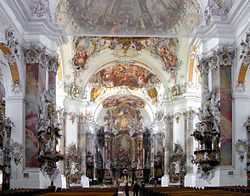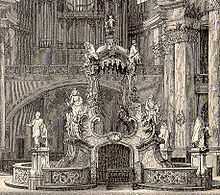Johann Michael Feuchtmayer

Johann Michael Feuchtmayer (the Younger) (sometimes spelled Johann Michael Feuchtmayr or Feichtmayr) (1709 – June 4, 1772) was a German Baroque stucco sculptor and plasterer of the Wessobrunner School, who worked alongside Johann Michael Fischer, Johann Joseph Christian, and Franz Joseph Spiegler to create some of the most famous churches along the Upper Swabian Baroque Route.
J. M. Feuchtmayer is considered to be one of the finest artists of his time.[1] His work on the Ottobeuren Abbey, one of the most magnificent churches of the Baroque era, was especially important. The stucco that dominates the design is his.[2]
Feuchtmayer was born in Wessobrunn, Bavaria. A member of the famous Feuchtmayer family, he was the son of Michael Feuchtmayer (b. 1667); the nephew of Franz Joseph Feuchtmayer (1660–1718) and Johann Michael Feuchtmayer (the Elder) (1666–1713); the brother of Franz Xaver Feuchtmayer (the Elder) (1705–1764); the cousin of Joseph Anton Feuchtmayer (1696–1770); and the uncle of Franz Xaver Feuchtmayer (the Younger) (b. 1735).
Major works


Austria
- Wilhering—Stiftskirche Mariä Himmelfahrt (stucco in transepts and choir)
Baden-Württemberg
- Bad Säckingen—Convent Church of St. Fridolin (1751) (stucco)
- Haigerloch—Pilgrimage Church of St. Anne (1753–1755) (stucco work and side altar design)
- Kisslegg—Neues Schloss (New Castle) (1721–1727) (stucco figures of the Sibyls on the staircase)
- Seeon im Chiemgau—Chapel of St. Nicholas at the Benedictine Monastery of St. Lambert (stucco)
- Sigmaringen—Catholic Parish Church of St. John the Evangelist (altars)
- Zwiefalten—Zwiefalten Abbey (1741–1747) (stucco)
Bavaria
- Amorbach—Benedictine Abbey Church of St. Maria (high altar and other altars)
- Augsburg—Dominican Church of St. Magdalena (1716) (stucco)
- Dießen am Ammersee—Church of St. Maria (completed 1739) (stucco)
- Ottobeuren—Benedictine Monastery Church of the Holy Trinity (1737–1766) (stucco)
- Staffelstein—Pilgrimage Church of Vierzehnheiligen (stucco on the Gnadenaltar)
- Würzburg—Pilgrimage Church of St. Maria (Marienkapelle) (1747–1750) (stucco)
References
|